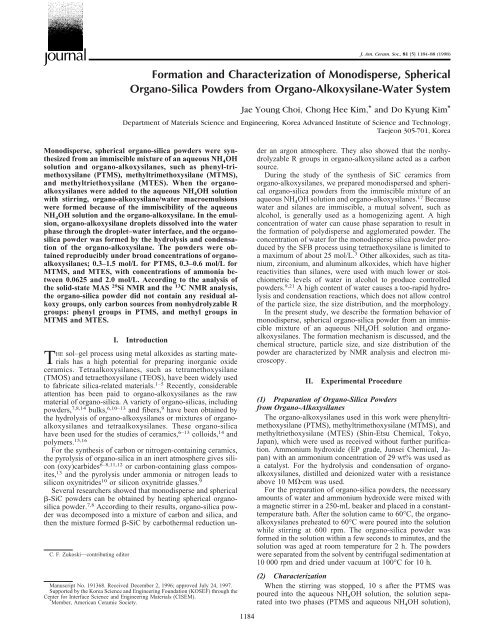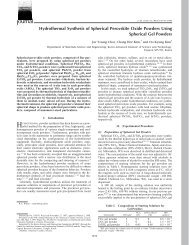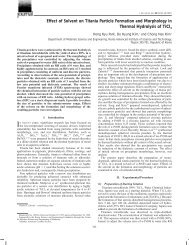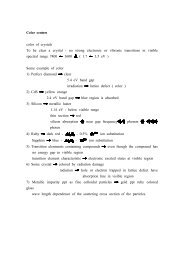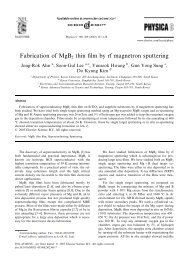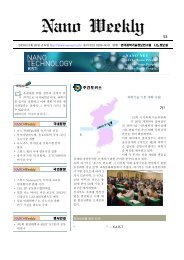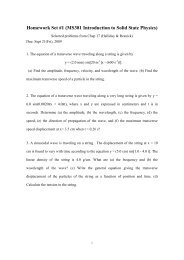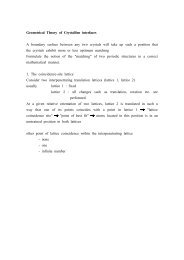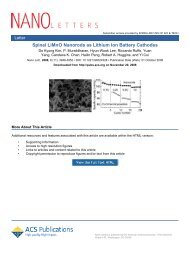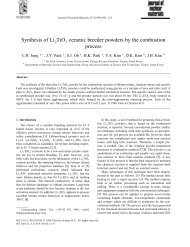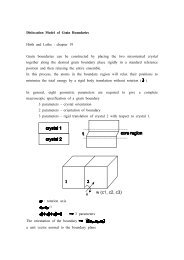Formation and Characterization of Monodisperse
Formation and Characterization of Monodisperse
Formation and Characterization of Monodisperse
Create successful ePaper yourself
Turn your PDF publications into a flip-book with our unique Google optimized e-Paper software.
Journal<br />
<strong>Formation</strong> <strong>and</strong> <strong>Characterization</strong> <strong>of</strong> <strong>Monodisperse</strong>, Spherical<br />
Organo-Silica Powders from Organo-Alkoxysilane-Water System<br />
Jae Young Choi, Chong Hee Kim,* <strong>and</strong> Do Kyung Kim*<br />
Department <strong>of</strong> Materials Science <strong>and</strong> Engineering, Korea Advanced Institute <strong>of</strong> Science <strong>and</strong> Technology,<br />
Taejeon 305-701, Korea<br />
<strong>Monodisperse</strong>, spherical organo-silica powders were synthesized<br />
from an immiscible mixture <strong>of</strong> an aqueous NH 4OH<br />
solution <strong>and</strong> organo-alkoxysilanes, such as phenyl-trimethoxysilane<br />
(PTMS), methyltrimethoxysilane (MTMS),<br />
<strong>and</strong> methyltriethoxysilane (MTES). When the organoalkoxysilanes<br />
were added to the aqueous NH 4OH solution<br />
with stirring, organo-alkoxysilane/water macroemulsions<br />
were formed because <strong>of</strong> the immiscibility <strong>of</strong> the aqueous<br />
NH 4OH solution <strong>and</strong> the organo-alkoxysilane. In the emulsion,<br />
organo-alkoxysilane droplets dissolved into the water<br />
phase through the droplet–water interface, <strong>and</strong> the organosilica<br />
powder was formed by the hydrolysis <strong>and</strong> condensation<br />
<strong>of</strong> the organo-alkoxysilane. The powders were obtained<br />
reproducibly under broad concentrations <strong>of</strong> organoalkoxysilanes;<br />
0.3–1.5 mol/L for PTMS, 0.3–0.6 mol/L for<br />
MTMS, <strong>and</strong> MTES, with concentrations <strong>of</strong> ammonia between<br />
0.0625 <strong>and</strong> 2.0 mol/L. According to the analysis <strong>of</strong><br />
the solid-state MAS 29 Si NMR <strong>and</strong> the 13 C NMR analysis,<br />
the organo-silica powder did not contain any residual alkoxy<br />
groups, only carbon sources from nonhydrolyzable R<br />
groups: phenyl groups in PTMS, <strong>and</strong> methyl groups in<br />
MTMS <strong>and</strong> MTES.<br />
I. Introduction<br />
THE sol–gel process using metal alkoxides as starting materials<br />
has a high potential for preparing inorganic oxide<br />
ceramics. Tetraalkoxysilanes, such as tetramethoxysilane<br />
(TMOS) <strong>and</strong> tetraethoxysilane (TEOS), have been widely used<br />
to fabricate silica-related materials. 1–5 Recently, considerable<br />
attention has been paid to organo-alkoxysilanes as the raw<br />
material <strong>of</strong> organo-silica. A variety <strong>of</strong> organo-silicas, including<br />
powders, 7,8,14 bulks, 6,10–13 <strong>and</strong> fibers, 9 have been obtained by<br />
the hydrolysis <strong>of</strong> organo-alkoxysilanes or mixtures <strong>of</strong> organoalkoxysilanes<br />
<strong>and</strong> tetraalkoxysilanes. These organo-silica<br />
have been used for the studies <strong>of</strong> ceramics, 6–13 colloids, 14 <strong>and</strong><br />
polymers. 15,16<br />
For the synthesis <strong>of</strong> carbon or nitrogen-containing ceramics,<br />
the pyrolysis <strong>of</strong> organo-silica in an inert atmosphere gives silicon<br />
(oxy)carbides6–8,11,12 or carbon-containing glass composites,<br />
13 <strong>and</strong> the pyrolysis under ammonia or nitrogen leads to<br />
silicon oxynitrides10 or silicon oxynitride glasses. 9<br />
Several researchers showed that monodisperse <strong>and</strong> spherical<br />
-SiC powders can be obtained by heating spherical organosilica<br />
powder. 7,8 According to their results, organo-silica powder<br />
was decomposed into a mixture <strong>of</strong> carbon <strong>and</strong> silica, <strong>and</strong><br />
then the mixture formed -SiC by carbothermal reduction un-<br />
C. F. Zukoski—contributing editor<br />
Manuscript No. 191368. Received December 2, 1996; approved July 24, 1997.<br />
Supported by the Korea Science <strong>and</strong> Engineering Foundation (KOSEF) through the<br />
Center for Interface Science <strong>and</strong> Engineering Materials (CISEM).<br />
*Member, American Ceramic Society.<br />
1184<br />
der an argon atmosphere. They also showed that the nonhydrolyzable<br />
R groups in organo-alkoxysilane acted as a carbon<br />
source.<br />
During the study <strong>of</strong> the synthesis <strong>of</strong> SiC ceramics from<br />
organo-alkoxysilanes, we prepared monodispersed <strong>and</strong> spherical<br />
organo-silica powders from the immiscible mixture <strong>of</strong> an<br />
aqueous NH 4OH solution <strong>and</strong> organo-alkoxysilanes. 17 Because<br />
water <strong>and</strong> silanes are immiscible, a mutual solvent, such as<br />
alcohol, is generally used as a homogenizing agent. A high<br />
concentration <strong>of</strong> water can cause phase separation to result in<br />
the formation <strong>of</strong> polydisperse <strong>and</strong> agglomerated powder. The<br />
concentration <strong>of</strong> water for the monodisperse silica powder produced<br />
by the SFB process using tetraethoxysilane is limited to<br />
a maximum <strong>of</strong> about 25 mol/L. 3 Other alkoxides, such as titanium,<br />
zirconium, <strong>and</strong> aluminum alkoxides, which have higher<br />
reactivities than silanes, were used with much lower or stoichiometric<br />
levels <strong>of</strong> water in alcohol to produce controlled<br />
powders. 9,21 A high content <strong>of</strong> water causes a too-rapid hydrolysis<br />
<strong>and</strong> condensation reactions, which does not allow control<br />
<strong>of</strong> the particle size, the size distribution, <strong>and</strong> the morphology.<br />
In the present study, we describe the formation behavior <strong>of</strong><br />
monodisperse, spherical organo-silica powder from an immiscible<br />
mixture <strong>of</strong> an aqueous NH 4OH solution <strong>and</strong> organoalkoxysilanes.<br />
The formation mechanism is discussed, <strong>and</strong> the<br />
chemical structure, particle size, <strong>and</strong> size distribution <strong>of</strong> the<br />
powder are characterized by NMR analysis <strong>and</strong> electron microscopy.<br />
II. Experimental Procedure<br />
J. Am. Ceram. Soc., 81 [5] 1184–88 (1998)<br />
(1) Preparation <strong>of</strong> Organo-Silica Powders<br />
from Organo-Alkoxysilanes<br />
The organo-alkoxysilanes used in this work were phenyltrimethoxysilane<br />
(PTMS), methyltrimethoxysilane (MTMS), <strong>and</strong><br />
methyltriethoxysilane (MTES) (Shin-Etsu Chemical, Tokyo,<br />
Japan), which were used as received without further purification.<br />
Ammonium hydroxide (EP grade, Junsei Chemical, Japan)<br />
with an ammonium concentration <strong>of</strong> 29 wt% was used as<br />
a catalyst. For the hydrolysis <strong>and</strong> condensation <strong>of</strong> organoalkoxysilanes,<br />
distilled <strong>and</strong> deionized water with a resistance<br />
above 10 Mcm was used.<br />
For the preparation <strong>of</strong> organo-silica powders, the necessary<br />
amounts <strong>of</strong> water <strong>and</strong> ammonium hydroxide were mixed with<br />
a magnetic stirrer in a 250-mL beaker <strong>and</strong> placed in a constanttemperature<br />
bath. After the solution came to 60°C, the organoalkoxysilanes<br />
preheated to 60°C were poured into the solution<br />
while stirring at 600 rpm. The organo-silica powder was<br />
formed in the solution within a few seconds to minutes, <strong>and</strong> the<br />
solution was aged at room temperature for 2 h. The powders<br />
were separated from the solvent by centrifugal sedimentation at<br />
10 000 rpm <strong>and</strong> dried under vacuum at 100°C for 10 h.<br />
(2) <strong>Characterization</strong><br />
When the stirring was stopped, 10 s after the PTMS was<br />
poured into the aqueous NH4OH solution, the solution separated<br />
into two phases (PTMS <strong>and</strong> aqueous NH4OH solution),
May 1998 Spherical Organo-Silica Powders from Organo-Alkoxysilane-Water System 1185<br />
<strong>and</strong> the organo-silica powder was not yet formed. A certain<br />
amount <strong>of</strong> each solution was taken out after the liquids were<br />
clearly separated. The reaction products in each solution were<br />
investigated by using liquid-state 29 Si <strong>and</strong> 1 H NMR spectroscopy<br />
(AM 300 spectrometer, Bruker, Billerica, MA). In the<br />
liquid-state 1 H NMR measurement, D 2O was used as a lock<br />
solvent. For the liquid-state 29 Si NMR measurement, tetramethylsilane<br />
(TMS) was used as a reference, chlor<strong>of</strong>orm<br />
(CDCl 3) as a lock solvent, <strong>and</strong> chromium acetylacetonate<br />
(Cr(acac) 3) as a nonpolar paramagnetic relaxation agent. A<br />
5-mm NMR tube with a solution <strong>of</strong> TMS <strong>and</strong> Cr(acac) 3 in<br />
CDCl 3 was inserted coaxially into the 12-mm sample tube to<br />
serve as a st<strong>and</strong>ard.<br />
Particle size, size distribution, <strong>and</strong> shape <strong>of</strong> the powders<br />
were determined by scanning electron microscopy (SEM).<br />
Three hundred particles were measured for each sample.<br />
To characterize the chemical structural <strong>of</strong> the organo-silica<br />
powders, solid-state cross polarization/magic-angle spinning<br />
(CP/MAS) 13 C NMR <strong>and</strong> solid-state magic-angle spinning<br />
(MAS) 29 Si NMR spectroscopy were used. The spectra were<br />
measured at room temperature in a Bruker AM 300 spectrometer<br />
with a Bruker solid-state accessory. For the solid-state<br />
CP/MAS 13 C spectra, T 1 <strong>of</strong> 1.4 s, a 90° pulse, a 1.75-s delay<br />
between pulses, <strong>and</strong> a contact time <strong>of</strong> 3.0 ms were used during<br />
the data acquisition, <strong>and</strong> a spinning speed <strong>of</strong> 4000 Hz was<br />
employed. Solid-state MAS 29 Si spectra were obtained at 4000<br />
Hz, a delay <strong>of</strong> 30 s between pulses, <strong>and</strong> a 90° pulse. A small<br />
amount <strong>of</strong> Cr(acac) 3 was used as a nonpolar paramagnetic relaxation<br />
agent.<br />
III. Results <strong>and</strong> Discussion<br />
(1) <strong>Formation</strong> <strong>of</strong> Organo-Silica Powders<br />
Figure 1 shows schematics <strong>of</strong> the formation <strong>of</strong> organo-silica<br />
powders. When organo-alkoxysilane was added to the aqueous<br />
NH 4OH solution, the organo-alkoxysilane (silane phase) <strong>and</strong><br />
the aqueous NH 4OH solution (water phase) separated into two<br />
phases (Fig. 1(A)). Stirring <strong>of</strong> the mixture formed the macroemulsion<br />
where the silane phase was dispersed as droplets <strong>of</strong><br />
the size <strong>of</strong> a few millimeters in the water phase (Fig. 1(B)).<br />
After a few seconds to minutes, the size <strong>of</strong> the silane droplets<br />
became smaller <strong>and</strong> the water phase turbid white to show that<br />
organo-silica powder started to form in the water phase. With<br />
further stirring, the silane droplets finally disappeared. The<br />
turbid time depended on the reagent concentration <strong>and</strong> was<br />
shorter at higher concentrations <strong>of</strong> organo-alkoxysilane <strong>and</strong><br />
ammonia. Figure 2 shows the variation <strong>of</strong> the turbid time with<br />
the concentration <strong>of</strong> organo-alkoxysilanes.<br />
Figure 3 shows SEM photographs <strong>of</strong> organo-silica powders<br />
prepared from various organo-alkoxysilanes. The powders<br />
were monodisperse <strong>and</strong> spherical. The average particle size <strong>and</strong><br />
the st<strong>and</strong>ard deviation <strong>of</strong> the organo-silica powders increased<br />
with increasing concentration <strong>of</strong> the organo-alkoxysilanes (Fig.<br />
4). <strong>Monodisperse</strong> powders were produced at concentrations <strong>of</strong><br />
0.3–0.6 mol/L MTMS <strong>and</strong> MTES. In the case <strong>of</strong> PTMS, its<br />
monodispersity was maintained up to as high as 2.0 mol/L<br />
silane concentration, where the volume ratio <strong>of</strong> aqueous<br />
NH 4OH solution to PTMS is 2.2:1. The concentration <strong>of</strong> ammonia<br />
was varied from 0.0625 to 2.0 mol/L for the synthesis <strong>of</strong><br />
the powder in the preliminary experiment. There was no visible<br />
effect <strong>of</strong> ammonia concentration on the monodispersity <strong>of</strong> the<br />
powder, but the mean particle size decreased slightly with increase<br />
<strong>of</strong> the ammonia concentration. The powders were obtained<br />
reproducibly in all <strong>of</strong> the experimental conditions.<br />
When the stirring was stopped prior to the formation <strong>of</strong> the<br />
powder after the pouring <strong>of</strong> the PTMS to the aqueous NH 4OH<br />
solution, the mixture separated clearly into two phases <strong>of</strong> water<br />
<strong>and</strong> silane as shown in Fig. 1(A). Each water <strong>and</strong> silane solution<br />
was poured into test tubes. Some portion <strong>of</strong> each solution<br />
was analyzed by liquid-state 1 H <strong>and</strong> 29 Si NMR spectroscopy.<br />
While alcohol <strong>and</strong> silane were detected in the water solution,<br />
Fig. 1. Schematic showing the formation <strong>of</strong> organo-silica powder in<br />
the mixture <strong>of</strong> aqueous NH 4OH solution <strong>and</strong> organo-alkoxysilane.<br />
Fig. 2. Variation <strong>of</strong> turbid time with the concentration <strong>of</strong> various<br />
organo-alkoxysilane. The concentration <strong>of</strong> ammonia is constant at 1.0<br />
mol/L.<br />
no alcohol was detected in the silane solution. After a few<br />
hours, powder formed in the test tube containing the water<br />
solution, but there was no change in the silane solution. These<br />
results indicate that the silane droplets in the organoalkoxysilane/water<br />
microemulsion dissolve into the water
1186 Journal <strong>of</strong> the American Ceramic Society—Choi et al. Vol. 81, No. 5<br />
Fig. 3. SEM micrographs <strong>of</strong> organo-silica powders which are prepared<br />
(A) PTMS, (B) MTMS, <strong>and</strong> (C) MTES. The concentrations <strong>of</strong><br />
organo-alkoxysilanes <strong>and</strong> ammonia are 0.6 <strong>and</strong> 1.0 mol/L, respectively.<br />
phase with hydrolysis <strong>and</strong> condensation to form organo-silica<br />
powder in the water phase (Fig. 1(C)). That is, the silane droplets<br />
acted as reservoirs <strong>of</strong> silane monomer <strong>and</strong> water phase as<br />
a pool for powder formation reactions.<br />
Generally, in the sol–gel process using silanes, alcohol is<br />
used as mutual solvent because silanes <strong>and</strong> water are immiscible.<br />
3,18,20 For monodisperse powder, the water content has<br />
been limited so as not to cause phase separation. However,<br />
Bridger et al. 20 synthesized monodisperse silica powder using<br />
a reaction mixture <strong>of</strong> TEOS, methanol, <strong>and</strong> water at water<br />
concentrations <strong>of</strong> 25–30 mol/L where TEOS was no longer<br />
totally miscible. Stirring the reaction mixtures dispersed TEOS<br />
as droplets. They pointed out that TEOS droplets acted as<br />
reservoirs <strong>of</strong> monomer. Similarly, we obtained monodisperse<br />
Fig. 4. Variation <strong>of</strong> mean particle size <strong>and</strong> st<strong>and</strong>ard deviation with<br />
the concentration <strong>of</strong> various organo-alkoxysilanes. The concentration<br />
<strong>of</strong> ammonia is constant at 1.0 mol/L. Error bar indicates the st<strong>and</strong>ard<br />
deviation.<br />
organo-silica powder from an immiscible mixture <strong>of</strong> organoalkoxysilane<br />
<strong>and</strong> water (no alcohol). Both <strong>of</strong> the two results are<br />
similar to the emulsion polymerization process 21 consisting <strong>of</strong><br />
water, oil, <strong>and</strong> surfactant. The surfactant is used for emulsion<br />
formation. In the emulsion polymerization, stability <strong>of</strong> emulsion<br />
is important for the control <strong>of</strong> powder size <strong>and</strong> size distribution.<br />
In this study, silane droplets, which form initially due<br />
to the phase immiscibility, act as reservoirs <strong>of</strong> silane monomer<br />
<strong>and</strong> finally dissolve because alcohol formed during the reaction<br />
acts as a mutual solvent. But it seems that silane droplets can<br />
be retained in a rather stable fashion in the water phase to<br />
provide silane monomer to water <strong>and</strong> disappear slowly. It was<br />
observed that transparent silane droplets were retained in a<br />
white turbid water phase where organo-silica powder has<br />
formed. This is attributed to the slow reaction kinetics <strong>of</strong><br />
silanes with water. Reaction kinetics <strong>of</strong> silanes are much<br />
slower than other metal alkoxides. Furthermore, reaction kinetics<br />
<strong>of</strong> organo-alkoxysilanes are slower than those <strong>of</strong> tetraalkoxysilanes<br />
in a base-catalyzed reaction, because <strong>of</strong> the<br />
inductive effect <strong>of</strong> organic groups in organo-alkoxysilanes.<br />
Those formation behaviors, where silane droplets acts as reservoirs<br />
<strong>of</strong> silane monomer, have a similarity to the case <strong>of</strong> the<br />
silane addition process. In the process, silane was added to a<br />
mixture <strong>of</strong> silica powder, water, <strong>and</strong> alcohol to increase the<br />
particle size <strong>of</strong> the silica. 3,14<br />
From the above discussion, it can be said that dissolving <strong>of</strong><br />
silane droplets can supply monomer sources to water phase,<br />
<strong>and</strong> the dissolving rates affect the nucleation <strong>and</strong> growth <strong>of</strong><br />
organo-silica powder in water phase. As shown in Fig. 2, the<br />
turbid times <strong>of</strong> MTMS are the fastest <strong>and</strong> MTES the slowest,<br />
which is attributed to the steric effect <strong>of</strong> bulky phenyl <strong>and</strong><br />
ethoxy groups in the organo-alkoxysilanes. It indicates that the<br />
dissolving rate <strong>of</strong> MTMS to water phase is the fastest <strong>and</strong><br />
MTES the slowest, with hydrolysis <strong>and</strong> condensation rates having<br />
the same trends. A high dissolving rate causes high initial<br />
supersaturation level in water phase for nucleation, which induces<br />
more nuclei resulting in the formation <strong>of</strong> smaller powder,<br />
as shown in Fig. 4, where the size <strong>of</strong> organo-silica powder from<br />
MTMS is the smallest <strong>and</strong> MTES the largest. Figure 4 also<br />
shows that increasing silane concentrations causes the increase<br />
<strong>of</strong> particle size. It can be said that increasing silane concentration<br />
has two kinds <strong>of</strong> effects; one is the increase <strong>of</strong> monomer<br />
supply for the growth <strong>of</strong> powder which causes the increase <strong>of</strong><br />
particle size, <strong>and</strong> the other is the increase <strong>of</strong> initial supersatu-
May 1998 Spherical Organo-Silica Powders from Organo-Alkoxysilane-Water System 1187<br />
Fig. 5. Solid-state MAS 29 Si NMR spectra <strong>of</strong> the organo-silica powders prepared from (A) PTMS, (B) MTMS, <strong>and</strong> (C) MTES. Initial solution<br />
contained 0.6 mol/L organo-alkoxysilane <strong>and</strong> 1.0 mol/L ammonia.<br />
ration level which causes the decrease <strong>of</strong> particle size. From the<br />
above results, it seems that the former effect is more dominant<br />
than the latter in this system.<br />
(2) <strong>Characterization</strong> <strong>of</strong> Organo-Silica Powders<br />
Solid-state 13C <strong>and</strong> 29Si NMR spectroscopy is a powerful<br />
method to characterize the chemical structure <strong>of</strong> the powders<br />
prepared from (organo-) alkoxysilanes. 14 Solid-state MAS 29Si NMR spectroscopy provides quantitative information about the<br />
condensation reaction, <strong>and</strong> solid-state 13C NMR spectroscopy<br />
is particularly useful in determining the extent <strong>of</strong> the hydrolysis<br />
reaction.<br />
Solid-state MAS 29Si NMR spectra <strong>of</strong> the organo-silica powders<br />
are shown in Fig. 5. In the case <strong>of</strong> the powder derived from<br />
PTMS, peaks at −77.2 <strong>and</strong> −69.3 ppm can be assigned to T3 <strong>and</strong> T2 , respectively. T1 peaks were too small to be analyzed in<br />
all the spectra.<br />
Figure 6 shows solid-state CP/MAS 13C NMR spectra <strong>of</strong><br />
organo-silica powders. In Fig. 6(A), which is a spectrum <strong>of</strong> the<br />
organo-silica powder derived from PTMS, peaks at 134.6,<br />
131.1, <strong>and</strong> 128.4 ppm are due to the carbons in the phenyl<br />
group. Because R groups are nonhydrolyzable, 14,18 they can<br />
remain in the molecular structure <strong>of</strong> the organo-silica powders<br />
after reaction. In this case, R groups are the phenyl for PTMS<br />
<strong>and</strong> the methyl for MTMS <strong>and</strong> MTES. Any peaks for residual<br />
methoxy groups were not observed in this spectrum. In the case<br />
<strong>of</strong> organo-silica powder from MTMS (Fig. 6(B)) <strong>and</strong> MTES<br />
(Fig. 6(C)), there are peaks only for the methyl group, not for<br />
the residual methoxy (Fig. 6(B)) <strong>and</strong> ethoxy (Fig. 6(C)). These<br />
results indicate that all the alkoxy groups in organoalkoxysilanes<br />
were hydrolyzed during the reaction, <strong>and</strong> the<br />
functional groups that remained without condensation in the T1 or T2 silicons (Fig. 5) are OH groups. This is contrasted with<br />
the case <strong>of</strong> the silica powder prepared from tetraethoxysilane in<br />
the aqueous alcohol solution containing ammonia (SFB process).<br />
Figure 7 shows the solid-state CP/MAS 13C NMR spectra<br />
<strong>of</strong> the silica powder synthesized from the SFB process. 1 In<br />
the spectrum, the ethoxy signal was observed at close to 60.8<br />
<strong>and</strong> 17.5 ppm. These peaks can be assigned to the residual<br />
ethoxy groups which remained in the silica powder without<br />
hydrolysis. In this work, extremely high concentrations <strong>of</strong> water<br />
(aqueous NH4OH solution) in the reaction solution leads the<br />
alkoxy groups <strong>of</strong> the organo-alkoxysilanes to be fully hydrolyzed<br />
to hydroxy groups. Therefore, the only carbon source in<br />
the organo-silica powders was the nonhydrolyzable R groups,<br />
which is an important carbon source for the formation <strong>of</strong> SiC<br />
during further heat treatment.<br />
IV. Conclusions<br />
<strong>Monodisperse</strong>, spherical organo-silica powders were synthesized<br />
from the organo-alkoxysilane (PTMS, MTMS, <strong>and</strong><br />
MTES)/water macroemulsion. In the emulsion, organo-alkoxy<br />
silane droplets dissolved into the water phase through the droplet–water<br />
interface, <strong>and</strong> the organo silica powder was formed<br />
by the hydrolysis <strong>and</strong> condensation <strong>of</strong> the organo-alkoxysilane.<br />
Because silanes react slowly with water, silane droplets could<br />
be dispersed stably in water to produce silane monomer to<br />
water phase.<br />
Fig. 6. Solid-state CP/MAS 13 C NMR spectra <strong>of</strong> organo-silica powders<br />
prepared from (A) PTMS, (B) MTMS, <strong>and</strong> (C) MTES. The concentrations<br />
<strong>of</strong> organo-alkoxysilanes <strong>and</strong> ammonia are 0.6 <strong>and</strong> 1.0<br />
mol/L, respectively. (ssb) represents a spinning side b<strong>and</strong>.
1188 Journal <strong>of</strong> the American Ceramic Society—Choi et al. Vol. 81, No. 5<br />
Fig. 7. Solid-state CP/MAS 13 C NMR spectrum <strong>of</strong> silica powder<br />
prepared by the hydrolysis <strong>of</strong> TEOS in aqueous ethanol solution containing<br />
ammonia. The concentrations <strong>of</strong> TEOS, ammonia, <strong>and</strong> water<br />
were 0.25, 1.0, <strong>and</strong> 20 mol/L, respectively.<br />
<strong>Monodisperse</strong> powder was obtained reproducibly under<br />
broad concentrations <strong>of</strong> the organo-alkoxysilanes: 0.3–1.5<br />
mol/L for PTMS, 0.3–0.6 mol/L for MTMS, <strong>and</strong> MTES, with<br />
the concentration <strong>of</strong> ammonia ranging from 0.0625 to 2.0<br />
mol/L.<br />
In contrast with the SFB process-derived silica powder,<br />
which contains residual alkoxy groups in the powder, the organo-silica<br />
powders produced in this study did not contain any<br />
residual alkoxy groups. This indicated that the alkoxy groups<br />
<strong>of</strong> organo-alkoxysilanes were fully hydrolyzed in the aqueous<br />
NH 4OH solution to be hydroxy groups. Therefore, the only<br />
carbon source in organo-silica powders was the nonhydrolyzable<br />
alkyl or phenyl group, which are important carbon sources<br />
for the formation <strong>of</strong> SiC ceramics during further heat treatment.<br />
References<br />
1 W. Stõber, A. Fink, <strong>and</strong> E. Bohn, ‘‘Controlled Growth <strong>of</strong> <strong>Monodisperse</strong>d<br />
Silica Spheres in the Micro Size Range,’’ J. Colloid Interface Sci., 26, 62–69<br />
(1968).<br />
2 A. Van Blaaderen <strong>and</strong> A. P. M. Kentgens, ‘‘Particle Morphology <strong>and</strong><br />
Chemical Microstructure <strong>of</strong> Colloidal Silica Sphere Made from Alkoxysilanes,’’<br />
J. Non-Cryst. Solids, 149, 161–78 (1992).<br />
3 G. H. Bogush, M. A. Tracy, <strong>and</strong> C. F. Zukoski IV, ‘‘Preparation <strong>of</strong> <strong>Monodisperse</strong><br />
Silica Particles: Control <strong>of</strong> Size <strong>and</strong> Mass Fraction,’’ J. Non-Cryst.<br />
Solids, 104, 95–106 (1988).<br />
4 G. H. Bogush <strong>and</strong> C. F. Zukoski IV, ‘‘Uniform Silica Particle Precipitation:<br />
An Aggregative Growth Model,’’ J. Colloid Interface Sci., 142, 19–34 (1991).<br />
5 M. Yamane, S. Inoue, <strong>and</strong> A. Yasumori, ‘‘Sol–Gel Transition in the Hydrolysis<br />
<strong>of</strong> Silicon Methoxide,’’ J. Non-Cryst. Solids, 63, 13–21 (1984).<br />
6 D. A. White, S. M. Oleff, R. D. Boyer, P. A. Budinger, <strong>and</strong> J. R. Fox,<br />
‘‘Preparation <strong>of</strong> Silicon Carbide from Organosilicon Gels: I, Synthesis <strong>and</strong><br />
<strong>Characterization</strong> <strong>of</strong> Precursor Gels,’’ Adv. Ceram. Mater., 2, 45–52 (1987).<br />
7 F. Hatakeyama <strong>and</strong> S. Kanzaki, ‘‘Synthesis <strong>of</strong> <strong>Monodisperse</strong>d Spherical<br />
-Silicon Carbide Powder by a Sol–Gel Process,’’ J. Am. Ceram. Soc., 73 [7]<br />
2107–10 (1990).<br />
8 I. S. Seog <strong>and</strong> C. H. Kim, ‘‘Preparation <strong>of</strong> <strong>Monodisperse</strong>d Spherical Silicon<br />
Carbide by the Sol–Gel Method,’’ J. Mater. Sci., 28, 3277–83 (1993).<br />
9 K. Kamiya, M. Ohya, <strong>and</strong> T. Yoko, ‘‘Nitrogen-Containing SiO2 Glass Fibers<br />
Prepared by Ammonolysis <strong>of</strong> Gel Made from Alkoxides,’’ J. Non-Cryst. Solids,<br />
83, 208–22 (1986).<br />
10 Y. F. Yu <strong>and</strong> T. I. Mah, ‘‘Si-O-N Ceramics from Organosilicon Polymers’’;<br />
pp. 559–64 in Better Ceramics Through Chemistry II. Edited by C. J. Brinker,<br />
D. E. Clark, <strong>and</strong> D. R. Ulrich. Materials Research Society, Pittsburgh, PA, 1986.<br />
11 H. Zhang <strong>and</strong> C. G. Pantano, ‘‘Synthesis <strong>and</strong> <strong>Characterization</strong> <strong>of</strong> Silicon<br />
Oxycarbide Glasses,’’ J. Am. Ceram. Soc., 73 [4] 958–63 (1990).<br />
12 F. Babonneau, L. Bois, <strong>and</strong> J. Livage, ‘‘Silicon Oxycarbides via Sol–Gel<br />
Route: <strong>Characterization</strong> <strong>of</strong> the Pyrolysis Process,’’ J. Non-Cryst. Solids,<br />
147&148, 280–84 (1992).<br />
13 K. Kamiya, T. Yoko, T. Sano, <strong>and</strong> K. Tanaka, ‘‘Distribution <strong>of</strong> Carbon<br />
Particles in Carbon/SiO 2 Glass Composites Made from CH 3Si(OC 2H 5) 3 by the<br />
Sol–Gel Method,’’ J. Non-Cryst. Solids, 119, 14–20 (1990).<br />
14 A. Van Blaaderen <strong>and</strong> A. Vrij, ‘‘Synthesis <strong>and</strong> <strong>Characterization</strong> <strong>of</strong> <strong>Monodisperse</strong><br />
Colloidal Organo-Silica Spheres,’’ J. Colloid Interface Sci., 156, 1–18<br />
(1993).<br />
15 T. Iwamoto, K. Morita, <strong>and</strong> J. D. Mackenzie, ‘‘Liquid State 29 Si NMR<br />
Study on the Sol–Gel Reaction Mechanisms <strong>of</strong> Ormosils,’’ J. Non-Cryst. Solids,<br />
159, 65–72 (1993).<br />
16 Y. Sugahara, S. Okada, K. Kuroda, <strong>and</strong> C. Kato, ‘‘ 29 Si-NMR Study <strong>of</strong><br />
Hydrolysis <strong>and</strong> Initial Polycondensation Process <strong>of</strong> Organoalkoxysilanes, I. Dimethyldiethoxysilane,’’<br />
J. Non-Cryst. Solids, 139, 25–34 (1992).<br />
17 J. Y. Choi, Y. T. Moon, C. H. Kim, <strong>and</strong> D. K. Kim, ‘‘Pyrolytic Conversion<br />
<strong>of</strong> Spherical Organo-Silica Powder to Silicon Nitride under Nitrogen,’’ J. Am.<br />
Ceram. Soc., in press.<br />
18 C. J. Brinker <strong>and</strong> G. W. Scherer, Sol–Gel Science; pp. 108. Academic<br />
Press, New York, 1990.<br />
19 T. Ogihara, H. Nakajima, T. Yanagawa, N. Ogata, K. Yoshida, <strong>and</strong> N.<br />
Matsushita, ‘‘Preparation <strong>of</strong> <strong>Monodisperse</strong>, Spherical Alumina Powders from<br />
Alkoxides,’’ J. Am. Ceram. Soc., 74 [9] 2263–69 (1991).<br />
20 K. Bridger, D. Fairhurst, <strong>and</strong> B. Vincent, ‘‘Nonaqueous Silica Dispersions<br />
Stabilized by Terminally-Grafted Polystyrene Chains,’’ J. Colloid Interface<br />
Sci., 68, 190–95 (1979).<br />
21 K. Osseo-Asare <strong>and</strong> F. J. Arrigada, ‘‘Synthesis <strong>of</strong> Nanosize Particles in<br />
Reverse Microemulsions’’; pp. 6–16 in Ceramic Transactions, Vol. 12, Ceramic<br />
Powder Science III. Edited by G. L. Messing, S. Hirano, H. Hausner. American<br />
Ceramic Society, Westerville, Ohio, 1990.


